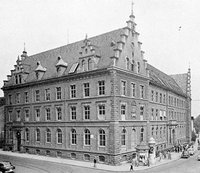1851: Abolition of the university?
In the proposal of December 1850 to abolish the university, various motives converged. Some hoped to establish a trade school, believing this to be a better purpose for the funds being used by the university. More generally, the enduring animosity toward the university was particularly fervent at this time, overlooking its benefits and taking offense at various political incidents and opinions. The widely hailed project of a Swiss national university gave additional ammunition to the university’s opponents by making Basel’s local university seem superfluous. A proposal to abolish the institution was nevertheless rejected in the City Council on 3 February 1851 by an overwhelming majority of 81 votes to 11.
According to Edgar Bonjour, since the university’s founding in 1460 there have always been citizens of the city who considered the institution – cherished as a gem by others – to be luxury requiring unnecessary expense. These reservations intensified whenever public funds were low, and they sharpened over the course of the nineteenth century as political clout shifted to social groups far removed from the institution. In Basel, the rising radicals saw the university as a cradle and stronghold of conservative forces. And the revival of the project to establish a Swiss national university – pursued this time with greater zeal – posed yet another threat. Criticism of the university’s significant expense was dubious for a number of reasons, not least the fact that its extremely complicated accounting system made it unclear how much the university was actually costing the canton.
This was perhaps the first – but certainly not the last – occasion when discussions about the educational budget would pit two categories of expenditures against each other: university outlays for a supposedly small circle of interested parties vs. the supposedly more legitimate educational needs of broader segments of the population. This “parasitic plant,” as it was called, was said to be siphoning off significant resources from the public schools; it could not compete with the new universities of Zurich and Bern; it should have been abolished during the favorable moment of the canton separation in 1833; it devoured too many resources with only seventy students and nearly half as many professors; and for the cost of one student at the university, twenty-five could be taught in primary schools. Representatives of the university had to argue that “their” institution was beneficial to society as a whole. The attack on the university, supported by the well-known radicals Karl Brenner and Wilhelm Klein, ultimately had the opposite effect. Eloquent defenders of the institution notably included the professor of law Johannes Schnell, the university rector at the time, and the respected chemist Christian Friedrich Schönbein, both of whom were German immigrants. City councillor Adolf Christ also threw himself into the battle playing out in the press. On 3 February 1851, a decision was made in favor of the university in a remarkably conclusive vote after a five-hour debate. The argument for establishing a trade school was that the abolition of guild monopolies had made an improvement in vocational training urgently necessary. Later, however, Basel secured a trade school and, in 1893, inaugurated a magnificent building located at the entrance of the Spalenvorstadt district, which is now shared with the university.



